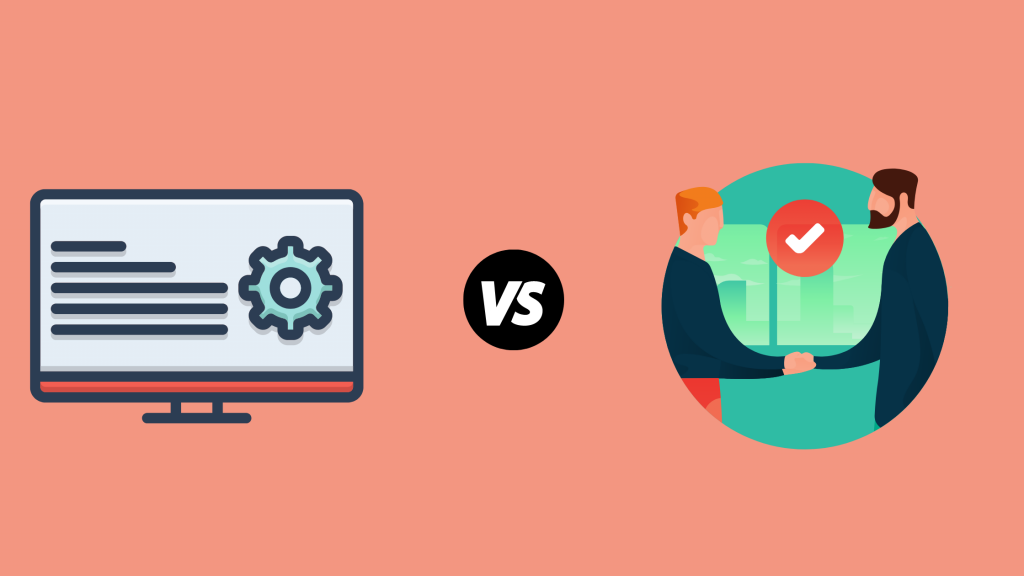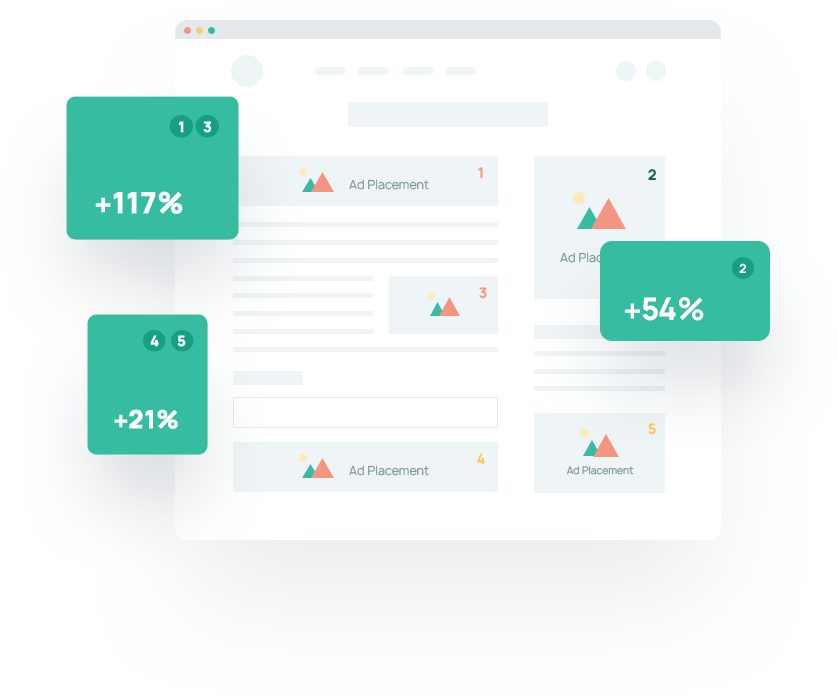
Whether you’ve just been initiated into the world of website monetization, or you’ve been doing it for years, one thing remains true: ads sell.
And when they sell well, it can give you a nice payout. The need for web publishers to make money through ad sales has led to the creation of several types of ad sales technologies. These technologies, fine-tuned after decades of trial, updates, and changes in industry thinking, connect publishers to the proper channels to sell their ad inventory to advertisers.
Publishers have the option to choose from a handful of methods—a private auction, a one-on-one relationship with an advertiser, or real-time bidding auctions, to name a few. These technologies fall under two major categories of selling ad inventory—programmatic deals and direct deals.
Programmatic vs. Direct Deals
Programmatic and direct deals are both effective methods of selling ad inventory with two very different approaches. Think of them as Helena and Hermia or Mario and Luigi. Different, but they have the same goal. And when working together, they make an iconic pair. So why are we talking about them?
Why Are They Hot Topics?
Programmatic deals have been around since 1994 but never truly came into their own until 2007. Now, in 2021, the method is predicted to make up 88% of all ad deliveries. What was once very niche is now trending among web publishers. But the method’s lack of transparency and safety issues, which we’ll get into a little later, are pushing publishers to start considering more direct deals.
With the growth we see in programmatic deals and the search for less risky ad inventory sales coinciding with each other, it’s important to consider your options. Depending on your position and strategy, one technique could prove more lucrative than the other.
But for now, you should know the differences between the deals so you can better follow trends and best practices.
Programmatic Deals
Programmatic deals are automated, from the auction to picking a winning bid. Mind you, this entire process happens in the time it takes one of your guests to load your webpage.
Once your visitor has landed on the page, your website generates and sends a bid request to an ad exchange provider. The ad exchange provider then sends this bid to advertisers that fit the bid’s specifications. The advertisers, called demand-side platforms, send back their bids. The system conducts an auction, and the highest bid wins.
When you opt for programmatic deals, you are using a strategy that targets demographics, location, and other data the website gathers from a user. Publishers don’t have to worry about providing this information. Advertisers have access to it through cookies.
Types of Programmatic Deals
If you come across an automated ad technology that involves an auction, it’s probably programmatic. Here are some of the more popular programmatic deals you’ll encounter as a web publisher.
- Real-Time Bidding (RTB): instantaneous bidding and auction, available to all bidders.
- Private Marketplace (PMP): invitation-only bidding on special ad packages. Unlike direct deals, this auction is automated.
- Private Marketplace Guaranteed: similar to a private marketplace, but selling inventory to one advertiser.
Direct Deals
Direct deals are personal and manual. As the name suggests, inventory transactions are direct, there are no auctions involved. The seller in a direct deal could be the web publisher themselves (if they have the time) or a contracted agency.
While programmatic looks at data, direct deals are based on the preferences of the web publisher. For instance, if you run a luxury clothing store and want ads specifically advertising high-quality purses, you’d look for a direct deal relationship with Coach, Prada, or Michael Kors. A web publisher could approach an advertiser in this way. But in most situations, an advertiser or third-party agency will contact a publisher with a request for proposal (RFP).
The two parties will then draw up a contract or some form of agreement that outlines terms and a fixed-rate price for the publisher’s inventory. A publisher may also offer a price without negotiating anything and the advertiser could simply reject or accept the offer. In this way, the process is similar to real-time bidding—except RTB is automated.
Different, but Compatible
Comparing the two, we can immediately see how different they are. But we shouldn’t assume that choosing the programmatic deal method means you don’t have time to sell ad inventory. And you shouldn’t assume that a direct deal means that there’s a special interest involved. As we said, web publishers need to make money, and strategizing ad technologies is just as important as selling ads.
Programmatic deals are great for selling ad inventory if you’re not too worried about revenue. If you’re dealing with a competent ad exchange service, you’re pretty much guaranteed a sale. Because it’s automated and can fill your webpage quickly, it’s a great option if you’re just starting out. You’ll just want to make sure you’re getting the transparency you need to host advertisements that are related to your website’s content.
While you’re getting started with programmatic deals, you have the opportunity to work on landing direct deals—especially because programmatic deals are automated. This gives you time to work out a relationship between your website and an advertiser.
Direct deals will generally bring in more money. I repeat: direct deals equals more money. So save your best ad space for these opportunities. Sticky ads are a great example of premium ad space. These types of ads have better click-through rates and are preferred by users on mobile platforms.
Pros & Cons of Programmatic Deals
We aren’t here to sway your decision one way or another, but the reality of programmatic deals is complicated. The method is so good, especially when it comes to real-time bidding, but you could run into some major problems. Let’s review some of the pros first.
Pros
Here are a few of the benefits you’ll find with programmatic deals:
- Automated process
- Zero contact with the advertiser
- Guaranteed income (in most cases)
- Efficient bulk inventory sales
- Produce reports on auctions and demographics
Programmatic deals are a great option for the publisher on the go and a publisher who isn’t relying solely on advertisements for sales. But as we transition to the cons, we’ll also see that it may be difficult for the publisher who wants complete control over their website.
Cons
We can’t ignore the cons of programmatic deals either:
- Susceptible to ad fraud
- You cannot handpick ads
In all of these situations, the publisher is a good arm’s length away from the actual activity. Ad fraud sneaks through even the most careful of publishers. You can’t control advertisers’ bids. And what your website’s visitors see in terms of ads is what they get.
Ad fraud is particularly important in this instance as it’s a major turn-off to serious advertisers. In 2019, research firm Advertiser Perceptions states that 37% of advertisers believe ad fraud is the worst aspect of the programmatic deal method. You could find yourself falling victim to a clickbot, spoofing, or ad stacking. If you want a better chance of earning money off of programmatic deal advertisements, secure your ad exchange platform.
Pros & Cons of Direct Deals
Okay moneymaker, let’s talk about direct deals. It would be great to have a fixed-rate, lucrative direct deal with an advertiser. But that’s not always possible. Still, the benefits of direct deals can make publishers incredibly happy.
Pros
Let’s go over the pros of direct deals:
- Fixed-rate pricing
- Control which ads are on your website
- Transparency
- Personal interaction with the advertiser
- Less susceptible to ad fraud than programmatic deals
- Great for niche advertisers
With direct deals, you get all the benefits of one-on-one business dealings. But it still means more work for the web publisher.
Cons
Now let’s turn to the cons of direct deals:
- Manual
- Harder to find and maintain direct deals
- Does not guarantee the sale of complete ad inventory
When you take on a direct deal method, you are committing to the work involved. You’ll have to be more diligent when you search for advertisers and make more of an effort to sell all of your inventory. It’s up to you—not a computer.
Which Method Should I Use?
Again, we can’t tell you which method is best for you, but we do know that there’s not one basic answer to this question. You’ll have to think about the demands of your website and your goals as a publisher. You’ll also need to consider how the quality of your website and the size of your audience will draw in potential advertisers.
Direct deals involve premium ad spaces and overall website desirability. If you are a metalworks blogger, for example, you’ll want to target advertisers who specialize in metalworks, metalworking tools, etc. At the same time, you’ll want your website to be attractive enough that the metalworks company would want to come to you with an offer.
If you don’t have any particular preferences on what ads the visitors to your website see, or if you prefer an automated service, programmatic deals could be better for you. Despite its susceptibility to ad fraud and lack of transparency, the ad technology has helped publishers monetize their websites for decades and it shows no sign of slowing down.
Best of Both Worlds
Programmatic and direct deals both have their advantages when used correctly. Rather than choosing one or the other–and possibly missing out on revenue, let us provide you with both. At Newor Media, we offer competitive bidding from our premium partnership and have a holster of partners to conduct direct deals with.
